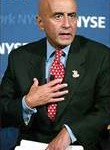
“The system is presented as having such a mystique that apparent evil becomes a kind of good.” ––The Organization Man, William Wythe, Chapter 19
Wall Street abhors change, so an examination of its past presents great insights into its future.
Here is one very significant object lesson from the New York Stock Exchange which simultaneously demonstrates inbred anti-fiduciary practices, corporate intimidation and cronyism, and sanctioned unethical behavior from a well-regarded consulting firm.
This story concerns the astounding $188.8 million bonus paid to former NYSE Chairman Dick Grasso and the role of former New York Attorney General Elliot Spitzer’s pressure on a former NYSE Executive Vice President, with authority over human resources and executive compensation, who intimidated NYSE board members to support Grasso’s record-breaking bonus package.
In this single story, students of Wall Street’s pathological behavior will see actual examples of fiduciary breaches, the failure of independent board directors to fulfill their duties and an astounding application of greed. in short, this short story has all the elements of a solid corporate case study of pathological behavior.
Also, in the interests of full disclosure, I am a former NYSE employee and have met Grasso and Frank Ashen, the former NYSE executive vice president, who reached a plea agreement with Spitzer to avoid being charged with a criminal breach of fiduciary duty.
What follows are actual news reports about corporate intimidation, fiduciary abuses and Grasso’s excessive bonus.
NEW YORK (Reuters) May 23-2004- A former New York Stock Exchange executive closely linked to the $188.5 million compensation package of former chief executive Richard Grasso has reached a deal with New York Attorney General Eliot Spitzer, CNBC reported on Monday.
Frank Ashen, a former NYSE executive vice president, struck a deal in order to avoid being charged by Spitzer with a breach of fiduciary duty, the cable television network said. Spitzer is expected to file suit against Grasso, as well as other former Big Board directors, as early as today.
Source: PR Release from Spitzer’s Office, May 24, 2004

Former NYSE Chief Sued Over Excessive Pay Package
Attorney General Eliot Spitzer today sued the former CEO of the New York Stock Exchange, a former Director, and the Exchange, citing violations of New York’s Not-for-Profit Corporation Law in the award of an excessive compensation package.
The civil law suit comes after a four-month investigation by Spitzer’s office determined that Directors of the NYSE were misled about various aspects of the $187.5 million payment package awarded by the Exchange to former Chairman and CEO Richard Grasso.
In a related action, Spitzer announced settlements with an NYSE executive and an independent consultant who both admitted providing information to the board that was inaccurate and incomplete.
The suit asks a state court judge to rescind the pay package and to determine a “reasonable” level of compensation for Mr. Grasso. The suit, which names Grasso and Kenneth G. Langone, former chairman of the NYSE Compensation Committee, was filed today in State Supreme Court in Manhattan.
The New York Stock Exchange was named in the suit because it failed to ensure compliance with the not-for-profit-law and made the excessive payments to Grasso.

“This case demonstrates everything that can go wrong in setting executive compensation,” Spitzer said. “The lack of proper information, the stifling of internal debate, the failure of board members to conduct proper inquiry and the unabashed pursuit of personal gain resulted in a wholly inappropriate and illegal compensation package.”
Spitzer’s suit alleges that:
–The NYSE Board of Directors was misled on various aspects of the Grasso compensation contract.
Inaccurate and misleading information in the form of incomplete and incorrect analyses were provided to Board members. Frank Z. Ashen, a top deputy to Grasso, admitted providing “incomplete, inaccurate and misleading” information in documents to the Board. In one example, the Board was not aware of $18 million in so-called Capital Accumulation Plan (CAP) bonus awards to Grasso for 1999-2001. In addition, Mercer Human Resource Consulting, Inc., a consultant asked to prepare a financial analysis of a proposed $187.5 million payment to Grasso, has admitted that its report to the Board contained “inaccuracies and omissions.”
–The compensation formula that generated huge payments for Grasso was flawed and under Grasso’s control.
–The compensation formula was inappropriately driven by a comparison with the salaries of top executives in the world’s largest corporations. In addition, the investigation found that Grasso, in effect, set his own performance targets, which he easily exceeded. In any event, the NYSE disregarded its own formula on numerous occasions and awarded Grasso funds well beyond the formula’s product.
–The compensation provided to Grasso was not “reasonable” according to state law.
New York Not-for-Profit Law requires that compensation for executives be “reasonable” and “commensurate with services provided.” In this case, however, the compensation far exceeded what would have been permitted by that standard. Indeed, the amount expended by the NYSE for Grasso’s compensation and benefits for 1999 through 2001 nearly equaled the NYSE’s total net income for those years.
–Grasso’s dual role as regulator and NYSE employee raised a conflict of interest.
Heads of major Wall Street investment banks were also members of the Compensation Committee. During the same period they approved Grasso’s excessive pay packages they had joined him in a private SEC-sponsored meeting at which they were assured that analyst conflicts of interest were “for the industry to resolve” without regulatory action.
The complaint also cites the testimony of one compensation committee member who privately expressed concern about a component of Grasso’s proposed compensation for the year 2000 and, subsequently, was personally confronted by Grasso. The director testified that he “was taken aback that my hesitancy was reported immediately (to Grasso).” The committee member, who ultimately approved Grasso’s compensation package, said: “Thank God I escaped that one. This man was also our regulator, and I’m a member of the New York Stock Exchange … and when he’s … your supervisor or your regulator, you have to be careful.”
Under the terms of his settlement with the Attorney General’s office, Ashen will return $1.3 million to the NYSE. Mercer Human Resources, Inc. will return the fees it charged the NYSE in 2003.
Spitzer thanked the SEC for working with his office on the investigation.
The Attorney General is responsible for enforcing the Not-for-Profit-Corporation Law (NPCL), which governs New York not-for-profit corporations and the conduct of their officers and directors. NPCL Section 720(b) authorizes the Attorney General to commence an action against a director or officer of a not-for-profit corporation to “to compel the defendant to account for his official conduct” with respect to “the neglect of, or failure to perform, or other violation of his duties in the management and disposition of corporate assets.” The law further authorizes the Attorney General to seek recovery of unreasonable compensation.
The investigation was led by Deputy Counsel Avi Schick with Assistant Attorneys General Bruce Topman, Robert Pigott and David Axinn and Legal Assistant Pascual Noble.
Attachment:
Supporting Materials: Complaint and Exhibits (PDF – 2.5MB)










